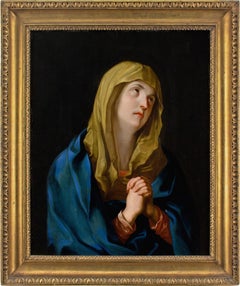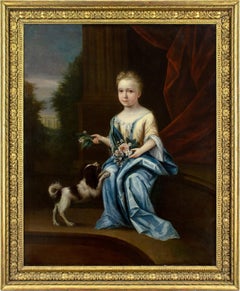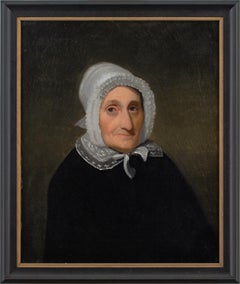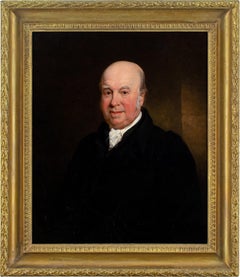Want more images or videos?
Request additional images or videos from the seller
1 of 13
Julius FriedländerJulius Friedländer, Portrait Of The Artist’s Mother, Oil Paintingc. 1830
c. 1830
$819.74List Price
About the Item
- Creator:Julius Friedländer (1810 - 1861, Danish)
- Creation Year:c. 1830
- Dimensions:Height: 11 in (27.94 cm)Width: 10 in (25.4 cm)
- Medium:
- Period:
- Condition:Artwork presents well. Frame with some light wear.
- Gallery Location:Cheltenham, GB
- Reference Number:1stDibs: LU2328213954712
About the Seller
5.0
Platinum Seller
Premium sellers with a 4.7+ rating and 24-hour response times
Established in 2017
1stDibs seller since 2023
245 sales on 1stDibs
Authenticity Guarantee
In the unlikely event there’s an issue with an item’s authenticity, contact us within 1 year for a full refund. DetailsMoney-Back Guarantee
If your item is not as described, is damaged in transit, or does not arrive, contact us within 7 days for a full refund. Details24-Hour Cancellation
You have a 24-hour grace period in which to reconsider your purchase, with no questions asked.Vetted Professional Sellers
Our world-class sellers must adhere to strict standards for service and quality, maintaining the integrity of our listings.Price-Match Guarantee
If you find that a seller listed the same item for a lower price elsewhere, we’ll match it.Trusted Global Delivery
Our best-in-class carrier network provides specialized shipping options worldwide, including custom delivery.You May Also Like
Bart & Lisa. (diptych).
Located in CAMPO REAL, ES
The diptych offers a unique interpretation of two iconic pop culture characters, Bart and Lisa Simpson. Both are depicted using plastic figurines, giving them a nostalgic and three-d...
Category
21st Century and Contemporary Realist Portrait Paintings
Materials
Canvas, Oil, Wood Panel
"Deep Breath" (2022) Oil Painting by Calvin Lai Featuring Two Acrobats
By Calvin Lai
Located in Denver, CO
Calvin Lai's (US based) "Deep Breath" is an original, handmade oil painting that depicts two acrobats, cast in red light, with the female figure balancing on the male figure.
Artis...
Category
2010s Contemporary Figurative Paintings
Materials
Oil, Wood Panel, Canvas
Orange Qipao I
By Inkyeong Baek
Located in New York, NY
Sensational paintings of glass vessels come to life in this dynamic exhibition featuring new works by Korean artist Inkyeong Baek. Demonstrating an uncanny ability to capture her sub...
Category
2010s Contemporary Portrait Paintings
Materials
Canvas, Wood, Cotton Canvas, Oil, Wood Panel
Red / Blue Qipao
By Inkyeong Baek
Located in New York, NY
Sensational paintings of glass vessels come to life in this dynamic exhibition featuring new works by Korean artist Inkyeong Baek. Demonstrating an uncanny ability to capture her sub...
Category
2010s Contemporary Portrait Paintings
Materials
Canvas, Wood, Cotton Canvas, Oil, Wood Panel
Green Qipao II
By Inkyeong Baek
Located in New York, NY
Sensational paintings of glass vessels come to life in this dynamic exhibition featuring new works by Korean artist Inkyeong Baek. Demonstrating an uncanny ability to capture her sub...
Category
2010s Contemporary Figurative Paintings
Materials
Canvas, Wood, Oil, Acrylic, Wood Panel
Yellow Green Qipao II
By Inkyeong Baek
Located in New York, NY
Sensational paintings of glass vessels come to life in this dynamic exhibition featuring new works by Korean artist Inkyeong Baek. Demonstrating an uncanny ability to capture her sub...
Category
2010s Contemporary Figurative Paintings
Materials
Canvas, Wood, Oil, Acrylic, Wood Panel
Portrait Sleeping Girl by Danish German Genre Painting Master 19th century
Located in Stockholm, SE
Johann August Frederik Carl Lorange (1833 - 1875) was highly skilled Danish artist of German roots. Not much known on his biography, unfortunately, but most of his works were produc...
Category
19th Century Realist Portrait Paintings
Materials
Canvas, Wood, Oil, Wood Panel
Fragment 2 (dreamy woman portrait face painting on wood, soft Earth tones)
By Rudolf Kosow
Located in Quebec, Quebec
"Fragment" by Rudolf Kosow is a compelling painting that intricately uses the medium of wood to enhance its textural and emotional depth. The artwork features a close-up of a human f...
Category
2010s Post-Impressionist Portrait Paintings
Materials
Canvas, Oil, Acrylic, Wood Panel
$900
H 9.85 in W 10.63 in D 0.99 in
Two royal portraits (the Duc d'Angoulême and the Duc de Berry) by H.P. Danloux
Located in PARIS, FR
These two royal portraits are a major historical testimony to the stay of the Comte d'Artois (the future Charles X) and his family in Edinburgh in 1796-1797. Given by the sitters to Lord Adam Gordon, the Governor of Edinburgh, and kept by family descent to this day, these two portraits provide us with a vivid and spontaneous image of the Duc d’Angoulême and his brother the Duc de Berry. Danloux, who had emigrated to London a few years before, demonstrate his full assimilation of the art of British portrait painters in the brilliant execution of these portraits.
1. Henri-Pierre Danloux, a portraitist in the revolutionary turmoil
Born in Paris in 1753, Henri-Pierre Danloux was first a pupil of the painter Nicolas-Bernard Lépicié (1735 - 1784) and then, in 1773, of Joseph-Marie Vien (1716 - 1809), whom he followed to Rome when, at the end of 1775, Vien became Director of the Académie de France. In Rome he became friends with the painter Jacques-Louis David (1748 - 1825).
Returning to France around 1782, he settled in Lyon for a few years before returning to Paris in 1785. One of his first portraits was commissioned by the Baroness d'Etigny, the widow of the former Intendant of the Provinces of Gascony, Bearn and Navarre Antoine Mégret d'Etigny (1719 – 1767). He then became close to his two sons, Mégret de Sérilly and Mégret d'Etigny, who in turn became his patrons. In 1787, this close relationship with the d'Etigny family was further strengthened by his marriage to Antoinette de Saint-Redan, a relative of Madame d'Etigny. After his marriage, he left for Rome and did not return to France until 1789. It was during the winter of 1790-1791 that he painted one of his masterpieces, the portrait of Baron de Besenval. Set in a twilight atmosphere, this portrait of an aristocrat who knows that his death is imminent symbolizes the disappearance of an erudite and refined society which would be swept away by the French Revolution.
The Jacobin excesses led Danloux to emigrate to England in 1792; many members of his family-in-law who remained in France were guillotined on 10 May 1794. Danloux enjoyed great success as a portrait painter in England before returning to France in 1801.
During his stay in England, Danloux was deeply under the influence of English portraitists: his colors became warmer (as shown by the portrait of the Duc d'Angoulême that we are presenting), and his execution broader.
2. Description of the two portraits and biographical details of the sitters
The Duc d'Angoulême (1775-1844) was the eldest son of the Comte d'Artois, the younger brother of King Louis XVI (the future King Charles X), and his wife Marie-Thérèse of Savoie. He is shown here, in the freshness of his youth, wearing the uniform of colonel-general of the "Angoulême-Dragons" regiment.
He is wearing the blue cordon of the Order of the Holy Spirit, which was awarded to him in 1787, and two decorations: the Cross of Saint-Louis and the Maltese Cross, as he was also Grand Prior of the Order of Malta.
Born on 16 August 1775 in Versailles, Louis-Antoine d'Artois followed his parents into emigration on 16 July 1789. In 1792, he joined the émigrés’ army led by the Prince de Condé. After his stay in Edinburgh (which will be further discussed), he went to the court of the future King Louis XVIII, who was in exile at the time, and in 1799 married his first cousin Marie-Thérèse Charlotte of France, the daughter of Louis XVI and the sole survivor of the royal family. The couple had no descendants. He became Dauphin of France in 1824, upon the accession to the throne of his father but played only a minor political role, preferring his military position as Grand Admiral. Enlisted in Spain on the side of Ferdinand VII, he returned home crowned with glory after his victory at Trocadero in 1823.
He reigned for a very short time at the abdication of Charles X in 1830, before relinquishing his rights in favor of his nephew Henri d'Artois, the Duc de Bordeaux. He then followed his father into exile and died on 3 June 1844 in Gorizia (now in Italy).
His younger brother, the Duc de Berry, is shown in the uniform of the noble cavalry of the émigrés’ Army. He is wearing the blue cordon of the Order of the Holy Spirit, awarded to him in May 1789, and the Cross of Saint-Louis (partly hidden by his blue cordon).
Born on 24 January 1778 in Versailles, Charles-Ferdinand d'Artois also followed his parents into emigration and joined the émigrés’ army in 1792. After his stay in Edinburgh, he remained in Great Britain, where he had an affair with Amy Brown...
Category
1790s Old Masters Portrait Paintings
Materials
Canvas, Oil, Wood Panel
Filipina Girl Playing the Harp
Located in Soquel, CA
Vibrant portrait of a Filipino girl playing a harp by an unknown artist (20th Century). This piece is done in the style of traditional Filipino art, with ...
Category
1970s Outsider Art Figurative Paintings
Materials
Canvas, Acrylic, Wood Panel
More From This Seller
View AllJoszef Schmidt, After Guido Reni Mater Dolorosa, Antique Oil Painting
Located in Cheltenham, GB
This early 19th-century oil painting by Hungarian artist Joszef Schmidt (1810-1875) depicts the Mater Dolorosa. It’s after a work by Italian artist, Guido Reni (1575-1642). Schmidt w...
Category
Early 19th Century Italian School Figurative Paintings
Materials
Panel, Oil
John Verelst (Circle), Portrait Of A Young Lady With A Spaniel
By John Verelst
Located in Cheltenham, GB
This large early 18th-century full-length portrait depicts a seated young lady before a classical column and distant country house. It was formerly in the collection of Dalham Hall i...
Category
Early 18th Century Rococo Portrait Paintings
Materials
Canvas, Oil
Mid-19th-Century French School, A Pair Of Nanas, 2 x Oil Paintings
Located in Cheltenham, GB
This charming pair of mid-19th-century French School portraits depicts two grandmothers, both presumably widows, wearing black gowns and white bonnets.
Alas, the identity of these r...
Category
Mid-19th Century Portrait Paintings
Materials
Canvas, Oil
Early 19th-Century English School Portrait Of Samuel Jones Of Skeyton, Norfolk
Located in Cheltenham, GB
This fine early 19th-century English oil painting depicts Samuel Jones of Skeyton, Norfolk, smartly attired in a black coat with white cravat. The portrait was previously in the coll...
Category
1830s Portrait Paintings
Materials
Oil, Canvas
George Clint ARA (Attributed), Portrait Of A Lady In A Brown Dress
Located in Cheltenham, GB
This early 19th-century half-length portrait attributed to British artist George Clint ARA (1770-1854) depicts a young lady wearing a beautiful brown dress, bonnet decorated with small flowers, gold earrings and coral necklace. Clint was a distinguished painter and mezzotint engraver predominantly known for portraiture and dramatic scenes.
Set before an evocative classically-inspired backdrop, she looks out from across the centuries with a composed demeanour. Adorned in the latest fashions, oversized ‘gigot’ sleeves, a delicately-poised bonnet, and a coral necklace for good luck. It’s a charming portrayal by a masterful hand.
Born at Drury Lane, in the heart of London’s West End, George Clint was destined to lead an exuberant life amid the spectacle of theatreland. His father, Michael Clint, was a hairdresser during a time of “hair pomatum, whalebone, wire, lace gauze, and feathers” - so young George would have encountered a variety of ‘characters’ during his childhood.
But despite these elevated surroundings, he soon discovered the darker side of London when thrust into the world of employment. Apprenticed initially as a fishmonger, he trained under a ferocious master who was known to beat him. The hours were unsocial, the conditions rank, and the work was brutal. He soon quit but subsequently found himself toiling for a corrupt attorney who demanded he undertake unscrupulous acts on his behalf.
Seeking a less volatile role, he turned next to house painting, at which he excelled. Commissioned, among other projects, to paint the stones of the arches in the nave of Westminster Abbey. Aside from an incident whereby he almost fell from the second story of a building, all was going well.
Following his marriage in 1792 to Sarah Coxhead, a farmer’s daughter, he began work in earnest as a painter of miniatures, determined to forge a career. Robert William Buss’ memoir celebrates Clint’s success as a miniaturist, stating that “great manual excellence was united with that chaste, delicate feeling for female beauty which characterised all Mr. Clint's portraits of ladies.”
Until this point, it appears he was predominantly self-taught, presumably constrained by a lack of finances. But from hereon in, his industrious nature coupled with several fortunate encounters, led to him developing an enviable talent for both painting and engraving. During the early 19th-century, the acquaintances one kept could make or break your fortunes and perhaps acutely aware of this, Clint’s ‘society’ was an ever-evolving circle of influential personalities.
He was “initiated into the mysteries of engraving” by Edward Bell (act.1794-1819) and produced numerous works after the foremost artists, such as George Stubbs, John Hoppner, and Thomas Lawrence. Following a commission from Lawrence, he struck up a long-term friendship.
Admired for his skill as a mezzotint engraver, he sought next to hone his technique in oils and, as with many aspiring portraitists, his first work in this respect was a depiction of his beloved wife. The pair were both delighted with it, yet over time Clint began to doubt himself and sought the validation of a superior hand - that of Sir William Beechey (1753-1839). However, paralysed with insecurity, he couldn’t face the potential criticism, so his wife took it instead - “with a child under one arm and the portrait in the other”. The result was immeasurably more positive than he’d envisaged and he became closely associated with Beechey until his death in 1839.
Numerous commissions followed from the landed gentry including Lord Egremont, Lord Spencer, and Lord Essex. But also from the theatrical community who would fill his studio at 83 Gower Street, Bloomsbury. His connections within the world of acting led to notable works such as ‘Malvolio and Sir Toby’ (from William Shakespeare's 'Twelfth Night', Act II, Scene iii)’ and ‘Harriet Smithson as Miss Dorillon, in Wives as They Were, and Maids as They Are’.
While his efforts in mezzotint included several contributions to JMW Turner’s Liber Studiorum.
As a measure of his success, Clint was elected an Associate of the Royal Academy in 1821 - a position he later relinquished for personal reasons. Today, he’s represented in numerous public collections including at The British Museum, Harvard Art Museums, The Met, V&A, Yale Center for British Art, and the National Portrait Gallery.
“The respect in which he was held, not only by his brother artists, but by an immense number of eminent men in various professions, and others of the highest rank, was the result of a rare combination of talent, candour, suavity of manner, and integrity of purpose”. [Obituary, 1854].
Housed in a period gilt frame, which is probably original.
Learn more about George Clint ARA in our directory.
Labels & Inscriptions: Supplier’s stencil from Rowney & Forster. The National Portrait Gallery holds a database of supplier’s stencils over the decades. The one here is also presented on two other works by George Clint. ‘Falstaff’s Assignation with Mrs Ford...
Category
1830s English School Portrait Paintings
Materials
Oil, Canvas
Jacques d'Agar (Circle), Portrait Of A Gentleman In A Silk Robe
Located in Cheltenham, GB
This enchanting late 17th-century French oil painting depicts an elegant gentleman in a silk robe with his right index finger on an open book. Stylistically, it’s comparable to the oeuvre of Jacques d'Agar (1640-1715).
Dressed in a rather ostentatious embroidered silk robe...
Category
1670s French School Portrait Paintings
Materials
Oil, Canvas
Recently Viewed
View AllMore Ways To Browse
Spain Old Masters
Dutch Master Portrait
English Gentleman Oil Portrait
Oil Paint Royal Portraits
Old Paris Painting
Portrait King George
Portrait Of Two Women
Robert Daughters
Sir Anthony Van Dyck
17 Century Portraits
17th Century Man Portrait
African American Portrait Painting
Coronation Painting
Danse Macabre
Military Portrait Paintings
Native American Portraits
Painting Of African Woman
Woman Portrait Black Dress



